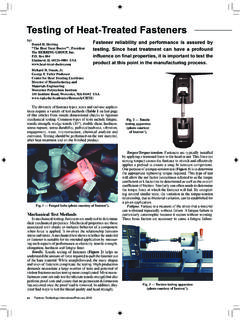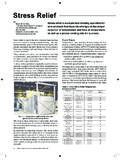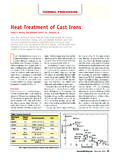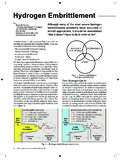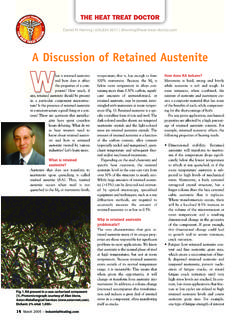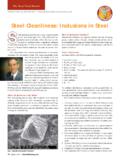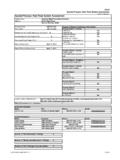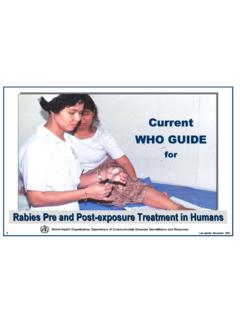Transcription of The Heat Treat Doctor
1 Ast time we learned something about the relationship between strength and toughness (Fig. 1).[1] A material may be strong and tough, exhibiting high strains if it ruptures under high loads. By contrast, brittle materials may be strong, but with limited strain values they are not tough. Generally speaking, strength indicates how much load/stress the material can sustain, while toughness indicates how much energy a material can absorb before rupturing. In our previous discussion on toughness we also talked about the need to discuss the infl uence of alloying elements, microstruc-ture, heat treatment, embrittlement phenomena and service con-ditions. Let s learn of Alloying Elements on ToughnessAlloying elements play an important role in infl uencing a host of mechanical properties (Table 1), not the least of which is tough-ness. As we all know, steels contain vari-ous alloying elements (and impurities) that infl uence the formation of new phases as well as interact with the crystal structures of austenite, ferrite and cementite.
2 Some of the alloying elements are austenite stabilizers ( , manganese and nickel), some are ferrite stabilizers ( , silicon, chromium and niobium) and still others are strong carbide formers ( , titanium, niobium, molybdenum and chromium). Of these effects, certain alloying elements ( , man-ganese, sulfur, aluminum, calcium and silicon) as well as oxygen infl uence the type, distribution and morphology of inclusions ( , oxides, sulfi des, silicates and nitrides). There is a strong effect of inclusions on fracture and mechanical properties. Coarse inclusions also serve as fatigue initiation sites and have been reported to initi-ate cleavage fracture. Here s a look at each individual element affecting toughness:[4] Calcium improves steel cleanliness by infl uencing the size, mor-phology and total number of inclusions; desulfurizes; and re-duces the tendency toward directional properties. Calcium also modifi es the shape of any remaining sulfi de inclusions so as to be less detrimental to mechanical properties.
3 Calcium has no effect on transformations occurring during heat treatment. Cerium, while itself a potent deoxidizer and desulfurizer, is add-ed to control the shape of inclusions in steel that has already been deoxidized and desulfurized by other additives. Cerium does not take part in heat -treating reactions. Chromium has a tendency to form hard and stable carbides. Chromium strongly affects hardenability, wear resistance, cor-rosion resistance, resistance to hydrogen attack and resistance to softening at elevated temperature ( greater creep and stress-rupture properties). Chromium has a strong affi nity for both carbon and nitrogen. Magnesium desulfurizes steel, and by its ability to infl uence sul-fi de inclusions improves ductility, formability and directional uniformity. Molybdenum is a potent hardenability agent that retards soften-ing at elevated temperature and improves corrosion resistance.
4 During heat treatment, molybdenum steels have a tendency to-ward surface decarburization. Molybdenum is a strong carbide former and reduces the tendency toward temper embrittlement. Nickel is an austenite stabilizer, that is, the A3 temperature will be depressed and in the presence of carbon so too will the A1 temperature. Nickel is a solid-solution strengthener, a weak hardenability agent and promotes high toughness (often in combination with chromium and vanadium), especially at low temperatures. While its effects are not strong, nickel does have some infl uence on heat -treating transformations retarding both pearlite and, to a greater extent, bainite reactions. Niobium has two principal uses in steels: as a grain refi ner and for the formation of extremely hard and stable carbides and car-bonitrides. Niobium has a strong ability to remove carbon from solid solution and thus has a negative effect on hardenability. Tantalum improves strength and forms fi ne precipitates, but in-creasing tantalum content has a negative effect on ductility.
5 Tellurium improves machinability but has no effect on the transformations occurring during heat treatment. Tellurium is a grain refi ner and can be added to steel to infl uence the size, shape, distribution and morphology of sulfi de inclusions, the result of which is an improvement in transverse toughness and certain mechanical properties. Vanadium promotes fi ne grain size ( retards grain growth during austenitizing), increases hardenability (when dissolved in austenite, although its effectiveness is diminished somewhat by its high affi nity for carbon) and improves wear resistance through the precipitation of carbides and nitrides. Toughness RevisitedDaniel H. Herring | 630-834-3017 | heat Treat DoctorabmrLL16 March 2011 - 1. Alloying elements with a favorable infl uence on mechani-cal properties (alphabetical listing)[3]HardenabilityStrengthToughnes sMachinabilityBoronCarbonCalciumLeadCarb onCobaltCeriumManganeseChromiumChromiumC hromiumPhosphorousManganeseCopperMagnesi umSeleniumMolybdenumManganeseMolybdenumS ulfurPhosphorousMolybdenumNickelTelluriu mTitaniumNickelNiobiumNiobiumTantalumPho sphorousTelluriumSiliconVanadiumTantalum ZirconiumTungstenVanadium Zirconium forms stable compounds with oxygen, sulfur, nitrogen and carbon, thus helping to control nonmetallic inclusions and the fi xation of nitrogen (primarily in boron steels).
6 The pres-ence of zirconium in quenched-and-tempered steels also reduces grain coars-ening/sensitivity and permits the use of higher hardening or carburizing temper-atures. Zirconium raises the yield/tensile ratio and improves ductility and impact strength, particularly in the transverse direction. In highly alloyed steels, duc-tility decreases while hardness improves. Its usefulness is limited for economic and processing Phenomena[5]High-strength quench-and-tempered steels are subject to a variety of embrittlement phenomena including quench embrittle-ment, tempered-martensite embrittlement, temper embrittlement, hydrogen embrit-tlement and liquid-metal embrittlement, to name a few. In addition, stainless steels are affected by sigma-phase embrittlement. The steel s carbon content has a signifi -cant impact on toughness under various tempering conditions (Fig. 2). The effects on toughness can be categorized as follows: Tempered martensite (blue) embrittle-ment (TME) is irreversible and results in a loss of room-temperature impact toughness and fracture resistance.
7 It manifests itself by ductile, cleavage and intergranular modes of fracture. Tempering in the range of 250-400 C (480-750 F) can result in TME. The interactive effect of both tempering temperature and carbon level on the magnitude of the temper-embrittlement effect is seen in Figure 2. Temper embrittlement (TE) results in the loss of ductility (or the increase in the ductile-to-brittle transition temper-ature) after tempering in the range of 375-575 C (700-1070 F) or slow cooling through this range. Impurities such as phosphorous, tin, arsenic and antimony strongly infl uence the susceptibility of a material to TE. In general, heating to temperatures above the embrittlement range for several hours followed by rapid cooling can reverse the effects. Quench embrittlement is an inter-granular mechanism of brittle fracture, especially in high-carbon ( C) steels during austenitizing and quench-ing.
8 Tempering is not required. It is sim-ilar to quench cracking, which is due to high surface tensile stresses during quenching. Carbon and phosphorous play a signifi cant role. Sigma-phase embrittlement results from the precipitation of an iron-chromium compound after holding austenitic or ferritic stainless steels for long peri-ods of time in the range of 560-980 C (1050-1800 F). Slow cooling through the range of 1040-650 C (1900-1200 F) produces the same effect as does quenching from this range followed by subsequent heating in the range of 560-850 C (850-1560 F).Effects of Primary Processing on ToughnessIn addition to a large number of inclu-sions, cracking during solidifi cation and hot working may introduce fl aws that compromise performance. In the case of hot working, incipient melting, precipita-tion of particles or ferrite formation in the austenite grain boundaries and resultant microvoid formation are believed to be the mechanisms involved.
9 By way of ex-ample, the microstructure of a hot-worked 5,000-pound roll (Fig. 3) reveals large chromium carbides in an intergranular network, creating a part with extremely poor fracture toughness. IHFor the conclusion and references, use this Mobile Tag or ThoughtsTo understand toughness, one must have a clear understanding of the role of alloy-ing elements as well as the various micro-structural infl uences affecting the end-use application. In addition, the relationship of ductility to toughness needs to be at the forefront of our thinking. Toughness is a complex subject, and our articles provide only a brief overview. The reader is encouraged to use the refer-ences provided and other materials for a more in-depth treatment of the subject. IH References1. Herring, D. H., Toughness, Industrial heat -ing, December Practical Maintenance ( )3. Technology, Products & Processes ( )4. Deeley, P. D.
10 , K. J. A. Kundig and H. R. Spen-delow, Jr., Ferroalloys & Alloying Additives Handbook, Shieldalloy Corporation, Krauss, George, Steels: Processing, Struc-ture, and Performance, ASM International, Herring, D. H., The Embrittlement Phe-nomena in Hardened and Tempered Steels, Industrial Heating, October, Practical Data for Metallurgists, 15th Edi-tion, The Timken Company, pp. ASM Handbook Series, ASM Mr. Craig Darragh, AgFox LLC, technical and editorial review. 18 March 2011 - 0 200 400 600 800 1000 1200 1400 Izod impact, ft. lb. / Rockwell CTempering temperature, FHardnessToughnessFig. 1. Relationship of hardness and tough-ness of 4140 steel after tempering for one hour[2]50403020100 Low pressureHigh pressureCVN impact energy, 0 100 200 300 400 Tempering temperature, C6040200 Fig. 2. Charpy V-notch energy absorbed in fracture of 41xx-series and 52100 steels tempered at various temperatures[5]Fig.
